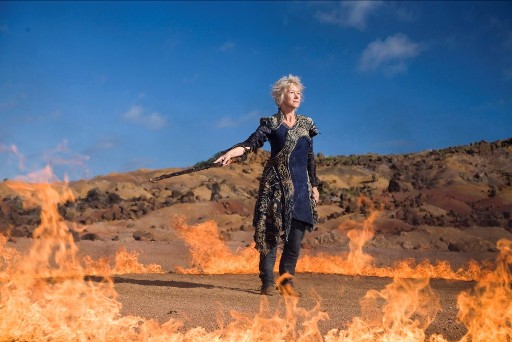Tempest | reviews, news & interviews
Tempest
Tempest
Helen Mirren is a beguiling Prospera in a film version that might have stayed indoors

Shakespeare’s The Tempest is apparently a gift for the big screen. It's full of tricks, illusions, two half-humans and of course kicks off with a stonker of a storm: any film-maker might, particularly in this hi-tech epoch, give his or her eye teeth to unleash wildest imaginings on this magical text for grabbiest effect. “The isle is full of noises,/ Sounds and sweet airs, that give delight and hurt not”, says Caliban.
Talk ahead of the film has indeed been of “gender-bending”, so expectations of something extreme might be high. In fact, Mirren is impressively staid as the island magus, once we’ve recovered at the film’s start from her histrionic roar - throwing her adversaries’ approaching ship into a tornado spin - and begins speaking all the great lines that follow with polished gravitas.
However, I don’t know if it’s DCI Tennison or Her Majesty interfering, but Dame Helen, beautiful with her blond boy’s cut, just isn’t quite deranged or distracted enough to evoke someone obsessed by books and magic (being surrounded in her lair by bubbling glass phials makes one think bathetically of Harry Potter) or a hyper-clever Milanese aristocrat embracing savage self-exile. She’s somehow too nice; Prospero isn’t, particularly, but maybe that’s Taymor’s point. The back story, shown in smoky flashback, also asks us to believe, along with other textual tweaks early on, that a 17th-century woman can rule a duchy and be a scholar of the occult.
Quibbles. Mirren (pictured above) is a beguiling Prospera in this femaled, not feminist, Tempest. Taymor has skilfully replaced the patriarchal dynamic of the original - magician as disciplinarian martinet - with a narrative of motherliness: Prospera really feels and fears for Miranda, played charmingly by 27-year-old Felicity Jones (who could, correctly, be 15), when encountering lithe young buck Ferdinand, Reeve Carney (who, by contrast, looks too geeky to have loved “full many a lady… for several virtues”…). Prospera’s relationship with a superimposed Ariel - Whishaw was unavailable for on-set work in Hawaii - is tender, almost erotic, though his naked, white, genital-free sprite (he sometimes sprouts breasts) zooms around over rock and wave like a jet-propelled Tinkerbell.
Caliban, played by a magnificently physical Djimon Hounsou (pictured below with Mirren and Felicity Jones), caked in scales and with one brown eye and one blue, screeches incomprehensibly in his first scenes, though has calmed down by the time he issues, movingly, the great “noises” speech (Act III, scene 2) in what resembles a prickly-pear forest. Alfred Molina gives us a dependably rotund, blubbery drunk Stephano, while Russell Brand as Trinculo is, equally dependably, Russell Brand, “v”ing his “th”s and his losing his “g” endings as he always irritatingly does (also reminiscent of another stand-up as a Shakespeare clown - they can never do it - some years ago when Sean Hughes was a dreadful Touchstone in David Lan’s As You Like It). The four shipwrecked Italians are good, Tom Conti unrecognisably so as the old, perplexed Gonzalo, Alan Cumming watchful and precise as the corruptible Sebastian - though the doublets of all four drip, disconcertingly, with un-17th-century zips. As for the biggest “but” - there was always one coming...
The four shipwrecked Italians are good, Tom Conti unrecognisably so as the old, perplexed Gonzalo, Alan Cumming watchful and precise as the corruptible Sebastian - though the doublets of all four drip, disconcertingly, with un-17th-century zips. As for the biggest “but” - there was always one coming...
Taymor struggled to get permission to film on the privately owned Lana’i and I just wonder whether the effort was worth it. Disney Studios' notes point out that it is very wild, volcanic and lunar, but it’s hard not to think, in the seaside scenes, of north Cornwall. The Tempest was written specifically for indoors: its oneiric poetry should and can do the transporting, not camera, island authenticity or, if on stage, an overbusy set.
Derek Jarman understood this precisely in his 1979 chuntering Heathcote Williams-sexy Toyah Wilcox film. It was dark, dressy, deeply strange - and set, claustrophobically, poetically, inside. Here, the play’s been taken outside and kind of left there. The key but difficult masque parade (Act IV, scene 1), whose vanishing precipitates "Our revels now are ended", becomes a very brief digital display in the sky which the Planetarium surely does better. Even in the scene of Prospera’s spell renunciation and capture of her usurping foes, a ring of fire on sand, looks like… a ring of fire on sand. The "set me free" epilogue, finally, is done as a song over the credits, books sinking through water: ingenious, perhaps, but dramatically a cop-out.
Taymor’s Tempest is faithful, narratively engaging and attractively new because of Mirren in the lead. But also, because it tries hard to be entertainingly "real", it remains strangely inert.
Watch the trailer for The Tempest
Explore topics
Share this article
The future of Arts Journalism
You can stop theartsdesk.com closing!
We urgently need financing to survive. Our fundraising drive has thus far raised £49,000 but we need to reach £100,000 or we will be forced to close. Please contribute here: https://gofund.me/c3f6033d
And if you can forward this information to anyone who might assist, we’d be grateful.

Subscribe to theartsdesk.com
Thank you for continuing to read our work on theartsdesk.com. For unlimited access to every article in its entirety, including our archive of more than 15,000 pieces, we're asking for £5 per month or £40 per year. We feel it's a very good deal, and hope you do too.
To take a subscription now simply click here.
And if you're looking for that extra gift for a friend or family member, why not treat them to a theartsdesk.com gift subscription?
more Film
 theartsdesk Q&A: filmmaker Dag Johan Haugerud on sex, love, and confusion in the modern world
The writer-director discusses first-love agony and ecstasy in 'Dreams', the opening UK installment of his 'Oslo Stories' trilogy
theartsdesk Q&A: filmmaker Dag Johan Haugerud on sex, love, and confusion in the modern world
The writer-director discusses first-love agony and ecstasy in 'Dreams', the opening UK installment of his 'Oslo Stories' trilogy
 Blu-ray: Two Way Stretch / Heavens Above
'Peak Sellers': two gems from a great comic actor in his prime
Blu-ray: Two Way Stretch / Heavens Above
'Peak Sellers': two gems from a great comic actor in his prime
 Late Shift review - life and death in an understaffed Swiss hospital
Petra Volpe directs Leonie Benesch in a compelling medical drama
Late Shift review - life and death in an understaffed Swiss hospital
Petra Volpe directs Leonie Benesch in a compelling medical drama
 The Naked Gun review - farce, slapstick and crass stupidity
Pamela Anderson and Liam Neeson put a retro spin on the Police Squad files
The Naked Gun review - farce, slapstick and crass stupidity
Pamela Anderson and Liam Neeson put a retro spin on the Police Squad files
 theartsdesk Q&A: actor Lars Eidinger on 'Dying' and loving the second half of life
The German star talks about playing the director's alter ego in a tormented family drama
theartsdesk Q&A: actor Lars Eidinger on 'Dying' and loving the second half of life
The German star talks about playing the director's alter ego in a tormented family drama
 The Fantastic Four: First Steps review - innocence regained
Marvel's original super-group return to fun, idealistic first principles
The Fantastic Four: First Steps review - innocence regained
Marvel's original super-group return to fun, idealistic first principles
 Dying review - they fuck you up, your mum and dad
Family dysfunction is at the heart of a quietly mesmerising German drama
Dying review - they fuck you up, your mum and dad
Family dysfunction is at the heart of a quietly mesmerising German drama
 theartsdesk Q&A: director Athina Rachel Tsangari on her brooding new film 'Harvest'
The Greek filmmaker talks about adapting Jim Crace's novel and putting the mercurial Caleb Landry Jones centre stage
theartsdesk Q&A: director Athina Rachel Tsangari on her brooding new film 'Harvest'
The Greek filmmaker talks about adapting Jim Crace's novel and putting the mercurial Caleb Landry Jones centre stage
 Blu-ray: The Rebel / The Punch and Judy Man
Tony Hancock's two film outings, newly remastered
Blu-ray: The Rebel / The Punch and Judy Man
Tony Hancock's two film outings, newly remastered
 The Ballad of Suzanne Césaire review - a mysterious silence
A black Caribbean Surrealist rebel obliquely remembered
The Ballad of Suzanne Césaire review - a mysterious silence
A black Caribbean Surrealist rebel obliquely remembered
 Harvest review - blood, barley and adaptation
An incandescent novel struggles to light up the screen
Harvest review - blood, barley and adaptation
An incandescent novel struggles to light up the screen
 Friendship review - toxic buddy alert
Dark comedy stars Tim Robinson as a social misfit with cringe benefits
Friendship review - toxic buddy alert
Dark comedy stars Tim Robinson as a social misfit with cringe benefits

Add comment